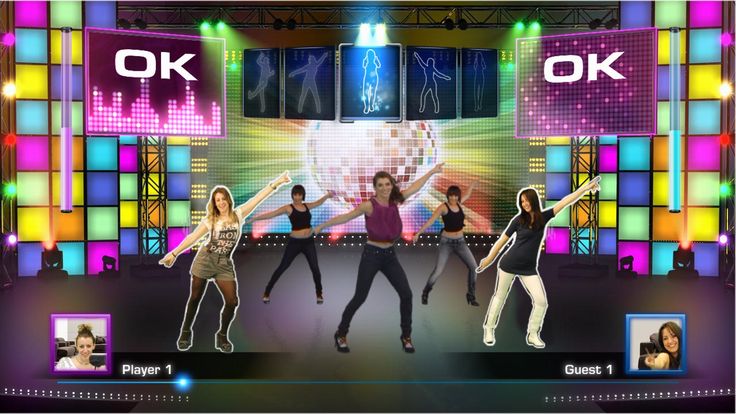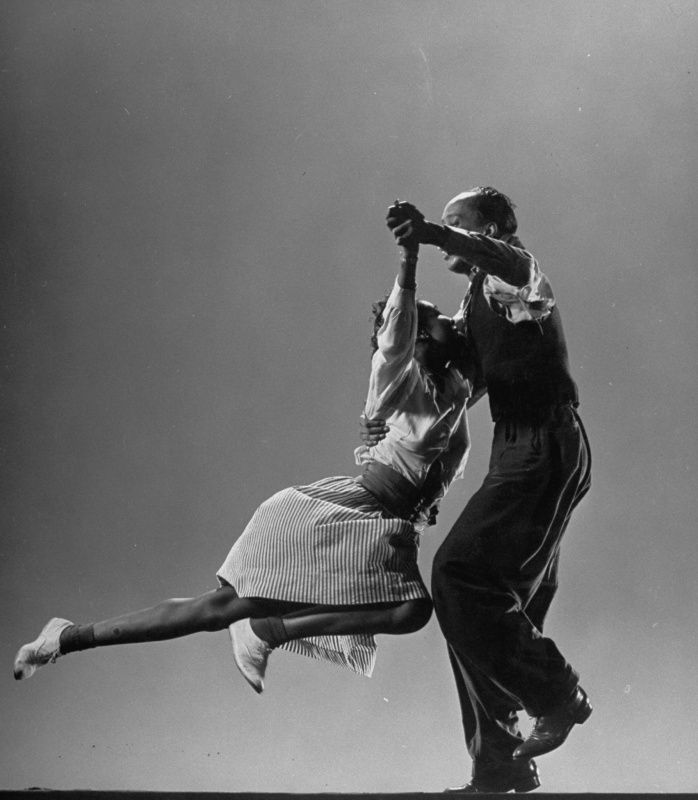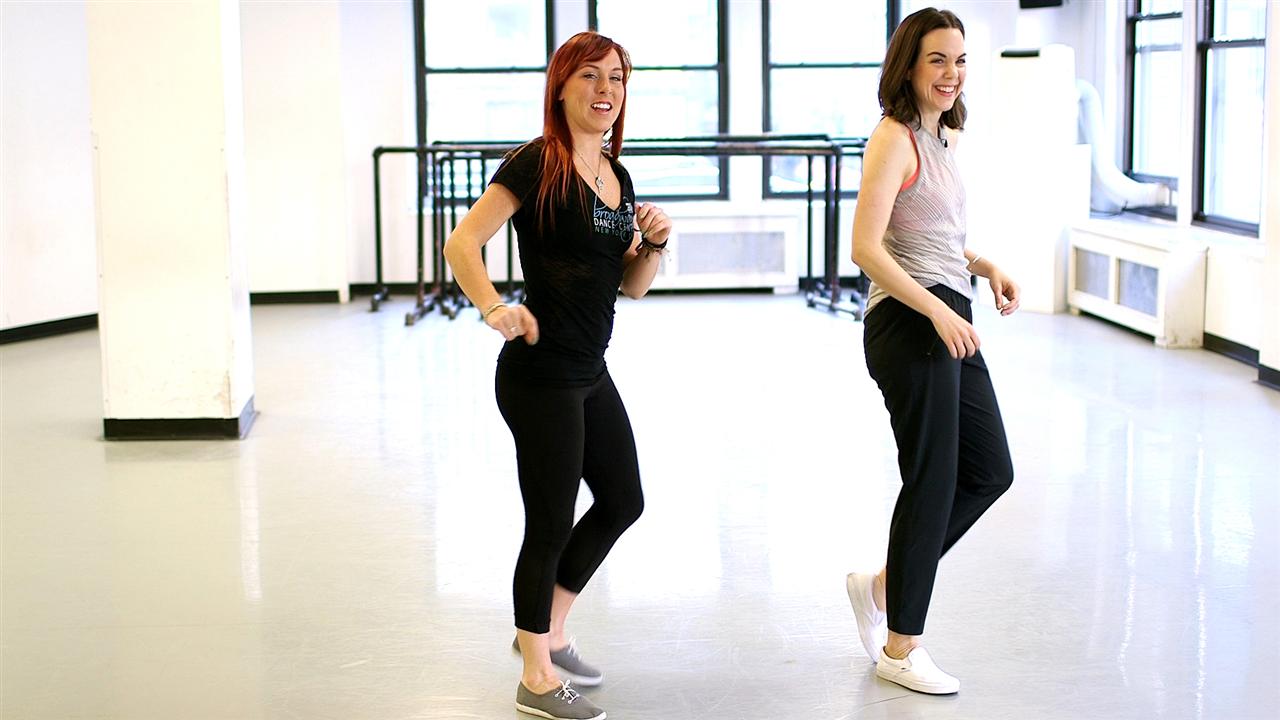How to do a russian dance
How to Dance like a Russian
From legendary folk dance to world-class ballet, Russia has a worldwide reputation for dance stretching back centuries. As any Russian would tell you, it is in their blood, and has become an intrinsic part of Russia’s national identity. As our way of paying homage to this much-loved art form, we will teach you about five Russian dances, from soaring leaps to high kicks and squats.
Prisyádka
When you think of ‘Russian dancing’ your mind probably conjures a man in a furry hat, doing a seemingly impossible, tip-toe squatted Can-can. The good news is that you’re right! This infamous dance isn’t simply a cartoon caricature of Russian culture, but the genuine thing; called, the prisyádka. The dance is an Eastern Slavic folk dance, not Cossack as many people assume. The moves originated centuries ago as a form of athletic competition, where excited onlookers would place bets as to which dancers would Kazotsky kick the most times, kick the highest or who might lose balance first. Reputation, masculinity and even fortunes have been won and lost for the sake of a Russian squat dance, and prisyádka is just the tip of the pointe shoe when it comes to the fascinating cultural history of Russian dance moves.
Russian Split
If you lack the balancing skills or leg muscles needed for successful squat dancing, you could attempt the gravity-defying ‘Russian Split’. This move, seen famously in figure skating routines performed by world-class skater Sasha Cohen, is a gazelle-like leap, achieving a straddle split five feet up in the air. Whilst these splits are considered ‘basic’ moves in the figure skating world, they are far from easy and when performed well and with height, they are breathtaking. In fact, a version of the Russian Split called the ‘Grande Jeté’ is one of the most exciting moves a ballerina can perform on stage. No wonder the best ballerinas in the world are Russian.
Khorovod
So perhaps not everyone can Kazotsky Kick or Russian Split, but there is good news for those of us who are less athletic.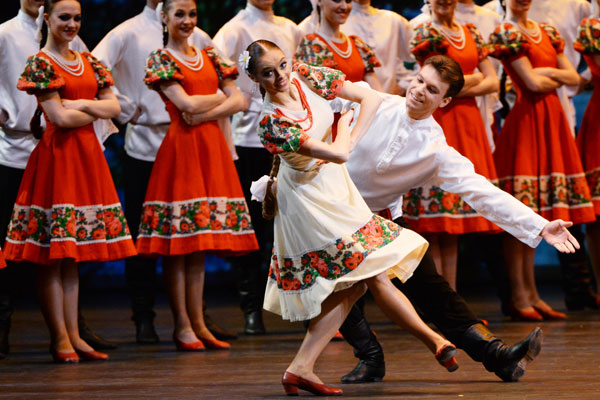 If you have little fingers, then this next dance could be perfect for you. The ancient Khorovod dance is documented for at least the last 1000 years in Russian and probably originates as far back as the dancing of Chorus groups in Ancient Greece. To get the moves right, you simply link pinkies with a fellow dancer and weave around the dance floor in a circular motion. In Belgorod, the locals achieved a world record of 2511 dancers in one Khorovod. But mind your geography, as in the Northern regions of Russia the dance is known to be gentle and restrained, but in the South, the dance has a more exciting reputation for hot-blooded frenetic movements and complex patterns.
If you have little fingers, then this next dance could be perfect for you. The ancient Khorovod dance is documented for at least the last 1000 years in Russian and probably originates as far back as the dancing of Chorus groups in Ancient Greece. To get the moves right, you simply link pinkies with a fellow dancer and weave around the dance floor in a circular motion. In Belgorod, the locals achieved a world record of 2511 dancers in one Khorovod. But mind your geography, as in the Northern regions of Russia the dance is known to be gentle and restrained, but in the South, the dance has a more exciting reputation for hot-blooded frenetic movements and complex patterns.
Troika (dance)
“But it is so hard to find a dance partner” I hear you cry. Well, should you find yourself in a dance hall where the number of women far outnumber the men then show no fear, simply request a ‘Troika’, a wholesome ménage a trois. Named after the traditional Russian ‘Troika’ chariots pulled by three horses, one man and two women imitate a prancing horse, much as you may have done as a child pretending to ride. With plenty of bouncing and elegant hoof work, you then duck under each other’s arms in a pleasing pattern. It’s a sociable and light-hearted folk dance that gives everyone a turn.
With plenty of bouncing and elegant hoof work, you then duck under each other’s arms in a pleasing pattern. It’s a sociable and light-hearted folk dance that gives everyone a turn.
Barynya
If you have no skill whatsoever, but possess determined enthusiasm for Russian cultural dances, then try the simple and passionate Barynya dance. Performed to lewd and humorous poem songs called ‘chastushkas’ in alternating tempos, this dance simply requires an un-choreographed, but heartfelt stomp around the dance floor. I think most of us can manage that at least.
So, there you are, five Russian dance moves for you to practice in your living room before you visit the real Russia and encounter these dances first-hand. But maybe wrap up the more valuable ornaments first!
- Comments
Rate this article:
Categories:
Number of views:
Tags:
Archive
-
2022, February 1
-
2022, January 3
-
2020, June 2
-
2020, May 4
-
2020, April 4
-
2020, March 4
-
2020, February 4
-
2020, January 5
-
2019, December 3
-
2019, November 5
-
2019, October 5
-
2019, September 4
-
2019, August 3
-
2019, July 1
-
2019, June 1
-
2019, April 2
-
2019, March 1
-
2019, February 5
-
2018, December 1
-
2018, October 3
-
2018, August 1
-
2018, July 3
-
2018, June 3
-
2018, May 8
-
2018, April 5
-
2018, March 2
-
2018, February 2
-
2018, January 4
-
2017, December 4
-
2017, November 3
-
2017, October 6
-
2017, September 2
-
2017, August 1
-
2017, July 3
-
2017, June 1
-
2017, May 3
-
2017, April 1
-
2017, March 1
-
2017, February 2
-
2016, August 2
-
2016, June 1
-
2016, January 2
-
2015, November 2
-
2015, October 4
-
2015, September 5
-
2015, August 4
-
2015, July 5
-
2015, June 6
-
2015, May 2
-
2015, April 2
-
2015, February 1
-
2015, January 3
-
2014, December 4
-
2014, November 1
-
2014, September 2
-
2014, August 2
-
2014, July 1
-
2014, June 2
-
2014, May 4
-
2014, April 2
-
2014, March 2
-
2014, February 2
-
2014, January 3
-
2013, November 1
-
2013, October 1
-
2013, September 5
-
2013, August 2
-
2013, July 4
-
2013, June 2
-
2013, May 4
-
2013, April 4
-
2013, March 3
-
2013, February 2
-
2013, January 4
-
2012, November 3
-
2012, October 8
-
2012, September 3
Rainbow, Russian folk dance performance at Pune
"Rainbow", the troupe from the Russian city of Voronezh was formed in 1979. The troupe was led by Mr. and Mrs. Belousov who have been decorated by the Russian Government. RADUGA is the honoured ensemble of people’s art and creativity. RADUGA is the winner at many international festivals in Algeria, Bulgaria, Germany, Holland, Egypt, Spain, Portugal, Tunicia, Sweden, France and Japan. Leaders of the ensemble RADUGA are honoured artists of the Russian Federation – They are Elena and Genady Belousovy. This year the ensemble is completing its 32 years. The singer Nadzda Bakuleva is the participant and winner of international festivals.
The troupe was led by Mr. and Mrs. Belousov who have been decorated by the Russian Government. RADUGA is the honoured ensemble of people’s art and creativity. RADUGA is the winner at many international festivals in Algeria, Bulgaria, Germany, Holland, Egypt, Spain, Portugal, Tunicia, Sweden, France and Japan. Leaders of the ensemble RADUGA are honoured artists of the Russian Federation – They are Elena and Genady Belousovy. This year the ensemble is completing its 32 years. The singer Nadzda Bakuleva is the participant and winner of international festivals.
Early History
The first Russian folk music and dance extends back into the 10th century, when Slavic tribes moved into Russia. The Slavs were known for their knowledge and mastery of instruments, songs and dance. Because of the many invasions of the country and the resulting inter-cultural mix, many of the original dances have either been combined with each other into new forms or been lost over time.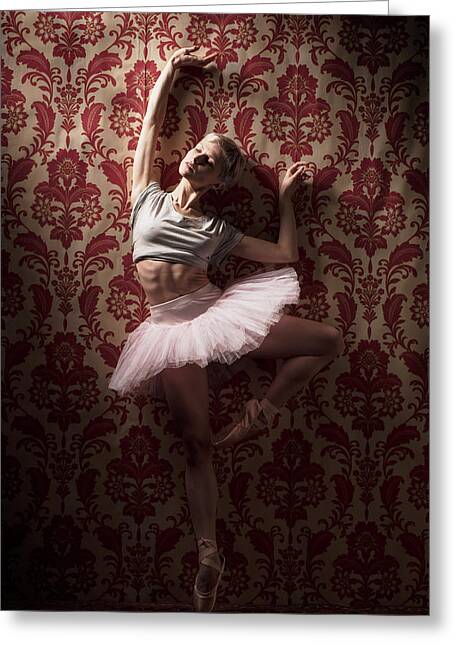
The first dances were only known by the peasants and the lowest classes. The upper classes and aristocracy did not dance themselves, but they instead enjoyed watching the performances of dance troupes and clowns. There were also street entertainers, or “skomorkhi,” who sang and danced and performed tricks as they wondered from town to town.
First Bear Dance
According to Russian dance director Mikhail Victorovich Smirnov, the first established record of Russian dance occurred in 907AD when Vechshiy Oleg, first grand prince of Kiev, was celebrating his victory at Constantinople. Although his troops could not infiltrate the city walls, they did force the Greeks to enter into a treaty. At the celebration, male dancers dressed up like bears, and several dancing bears were clothed like Russians. At the end of the feast, Oleg demanded the bears be released back into the wild and the dancers be executed. Apparently, Oleg, who was partially blind, thought the dancers were from the northern tribes who owed him numerous tiger skins.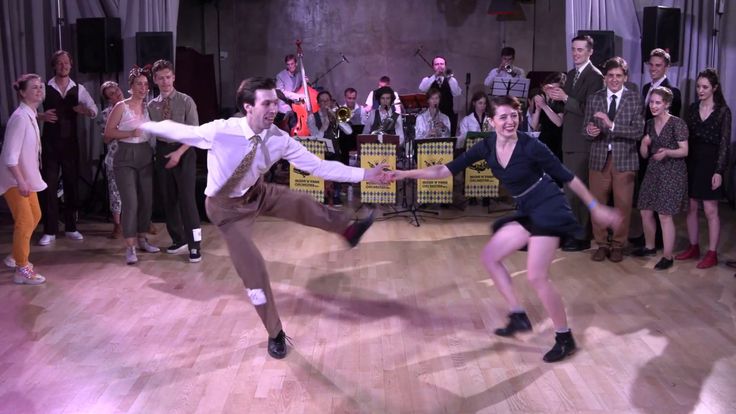
Holiday Traditions
Some of the Russian folk songs and dances were associated with calendar events, such as planting and harvesting and others with family rites, such as birth, weddings and funerals. Most Russian holidays are celebrated in the fall and winter when the farming is done for the year. The entertainment begins with a prayer and is followed with an abundant feast, singing, dancing and a series of entertaining fist fights or “stenka na stenku,” “wall against wall.”
Folk Dance Clothing
The clothing, which accompanied many of the dances, was also based on the event. Holiday headwear included a “kokoshnik,” or headdress that was decorated with pearls and gold thread; embroidered and decorated blouse or shirt; “sarafan,” or jumper; belt and ornamented apron. The primary colour was red, which meant “beautiful.” The men wore “kosovorotka,” or shirts fastened on the side; belts; narrow trousers; semi-high or high boots.
First Dance Troupe
In 1937, after the civil war came to an end, the Soviets organised the first Russian folk dance troupe under the direction of Igor Moiseyev. The troupe continues to be one of the top performers of folk dance worldwide. The dancing ensemble with its traditional music, dance and song, which is popular in the West, keeps the audience clapping and shouting praise. Moiseyev died in 2008 at the age of 101.
Moiseyev Dance Company
The Moiseyev Company embodies all of the Russian traditional folk dance arts and preserves the folk culture. The classically trained are more than dancers. The men and women in their traditional belted tunics and bright red dresses are also acrobatics, like today’s break dancers, with bodies spinning and zigzagging on the ground so fast they are almost impossible to see. The dancers fly into the air with their legs wide apart and their fingers touching their toes. While they are dancing, they are telling the story of the hundreds of years of Russian history and the many changes that occurred during the centuries.
While they are dancing, they are telling the story of the hundreds of years of Russian history and the many changes that occurred during the centuries.
Few Dance details found below:
Barynya
Barynya is a fast Russian folk dance and music. The word barynya (Russian: landlady) was used by simple folk as a form of addressing to a woman of higher class, a feminine form for the word "barin", landlord.
A number of Russian folkloric dance ensembles bear the name Barynya.
The Barynya dance is an alternation of chastushkas and frenetic dancing.
The Barynya chastuskas used to have the refrain, kind of "Barynya, barynya, sudarynya-barynya". The content was often humoristic, even lewd.
The dancing was without special choreography and consisted mainly of fancy stomping and traditional Russian squat work – knee bending (prisyadka).
There are a number of scenic, more refined versions of the dance.
Kamarinskaya
Khorovod
Khorovod (Russian) is a Slavic art form, a combination of a circle dance and chorus singing, similar to Chorea of ancient Greece.
Troika (dance)
Troika is a Russian folk dance, where a man dances with two women. The Russian word troika means three-horse team/gear. In the Russian dance the dancers imitate the prancing of horses pulling a sled or a carriage.
This dance is included into repertoires of virtually all Russian ethnographic dance ensembles. Similar folk dances are known among other Slavic peoples, e.g., the Polish Trojak.
A Cajun dance of the same name, Troika, exists, and is very similar to the Russian dance. It has been suggested (citation needed) that theCajun version of the dance originated at the times when Cossacks of the Russian tsar army were stationed in Paris.
Sequence of Dances and Songs
- The very first is Village , Village
In a small village a boy and a girl meet separately.
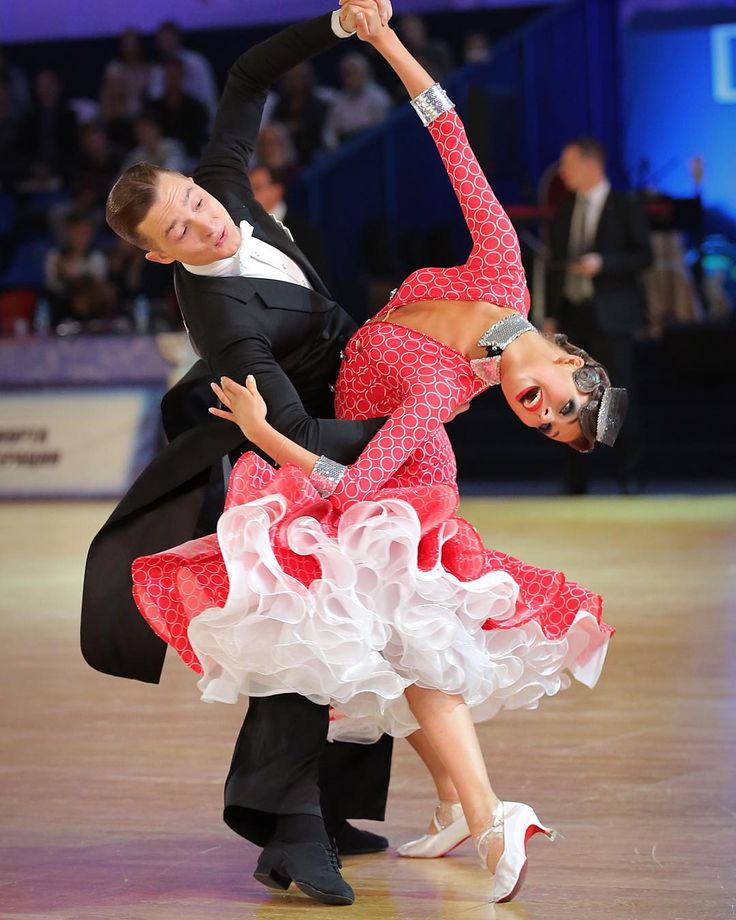 They join the dance. All of them dance together and leave together.
They join the dance. All of them dance together and leave together. - Dance of Spring
Along the grass and greenery. A dance of spring. A dance of green nature. The fresh grass welcomes everybody to run bare- footed on it. You can jump along it, you can lie down on it. In short, it allows you to be in Nature’s arms. - Girl Katyusha ( Song and Dance)
A world - famous Russian folk-song about a girl and about her beloved, who is on the front. Sung by Nadeza Bakulev & by the solo dancer of the ensemble M. Cheprasova. - A Dance with ropes (Dance)
In Russia every object can inspire you to dance be it beauty of somebody, be it a musical instrument or be it a plain rope. Girls use ropes to dance with boys. Boys show their skills in front of girls to make them jump and dance. - A dance with Kerchiefs (Dance)
A colourful folk dance. Kerchiefs will be adding more colours to it.
In a dance like this, girls answer to the boys, wooing them, with beautiful, colourful platochek.
Kerchiefs will be adding more colours to it.
In a dance like this, girls answer to the boys, wooing them, with beautiful, colourful platochek.
- The Voronezh Lozhkari (Dance)
In Russia people love to sing and dance to the tunes of any and every instrument. And any object can become an instrument for their dances. Even the spoons in the kitchen. - Who is better? (Dance)
A dance in pairs, who are competing with each other to prove - who is better ? Young boys and girls show who is stronger and who is better. - The Russian Fantasy (Dance)
Any festival is an eye-catching feast of dances-mainly group dances. Here we see different types of folk dances. - A young Lady (Dance)
This dance is about a young, beautiful woman, who had always been the Head of the family. In olden days, girls were taught to dance from a very early age.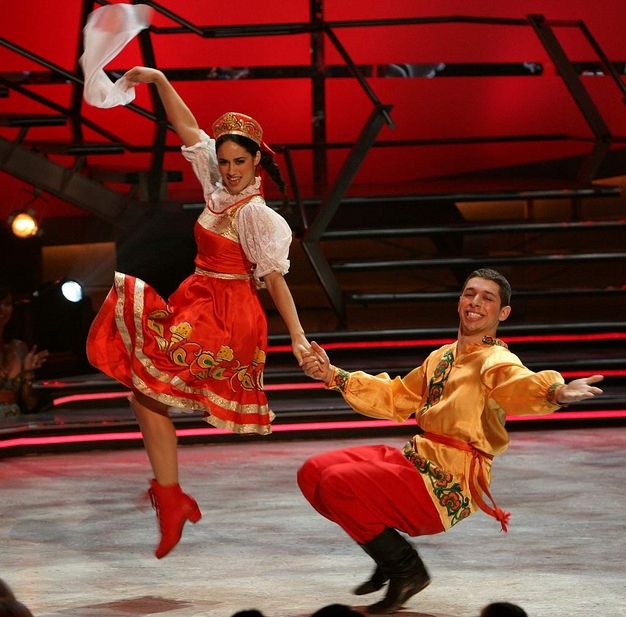 This dance is the embodiment of the dignity and beauty of Russian women.
This dance is the embodiment of the dignity and beauty of Russian women.
- This is what our people like (Song)
A Russian folk song, sung by Nadezda Bakuleva.
Russian people are not only beautiful dancers, but also they are melodious singers. In the village any festival is synonymous with Russian songs. They are at times very funny and they have a very deep meaning. - The evening has set in (Song)
Evening time is time for meeting, for romance and for enjoyment, sitting together at the sunset, young people are exchanging sweet nothings. A folk song, sung by Nadezda Bakuleva. - A sailor’s dance (Dance)
A dance by men. By sailors. Men are trying to show their better qualities in dance. Now a days girls are also performing this dance. - It is boring. It is sad. (Song)
A song, describing grief.
At times a very reigning good mood gets replaced by a bad one. Although a sad song, it is sung with hearty feelings. A Russian folk–song, sung by Nadezda Bakuleva. - (Song)
Troika is a famous Russian traditional horse-cart. Even when snow is lying in abundance, it can make its way very fast, with the speed of a lightening. A Russian folk-song, sung by Nadezda Bakuleva. - Gopak (Dance)
Gopak. This is a Ukrainian folk dance. The origin is in the word - Jump, jump, jump. - (Song)
What are the songs, sung in Russia?
Russian land is full of music. Its rich, its deep, its diverse. Songs are lively, they are happy, they are sad. All these songs are about life. A folk song, sung by Nadezda Bakuleva. - (Song)
Give me a balalaika.
Rainbow - Russian Folk DanceIt’s a light, funny song. This folk instrument is very popular in Russian. Russian people dance and sing to its tunes. Without balalaika, there is no celebration in Russia.
Song is going to be presented by Nadezda Bakuleva.
This folk instrument is very popular in Russian. Russian people dance and sing to its tunes. Without balalaika, there is no celebration in Russia.
Song is going to be presented by Nadezda Bakuleva.
- A dance with ‘balalaikas’ (Song)
Nadezda asked for the Balalaika and here they are. Here is the dance with 5 balalaikas. It’s a jolly, funful dance, full of joy and enjoyment.
Media Coverage
Russian folk dance - a guest from time immemorial Online publication "Elements of Dance"
To live a millennium is not a field to cross.
Only changes are constant in the world. And the fashion for dancing is also changing along with the lifestyle, new generations and their passions. Now it is hard to imagine that Russian folk dance will become as popular as samba, latina, bellydance and other modern styles. Of course, the Russian dance is not forgotten, but it is clearly not in favor with the masses of the people today. And absolutely in vain! It is bright, beautiful, emotional and able to give odds to all Western dance innovations!
And absolutely in vain! It is bright, beautiful, emotional and able to give odds to all Western dance innovations!
Fashion is fashion, and Russian dance was born long before hip-hop, lives with all new-fangled styles, and will continue to live, based on the fact that this is not just Russian folklore, but part of the deepest historical heritage, in which secret knowledge of the ancient Slavs, and the multifaceted Russian character, and way of life, and feelings, and unity with nature, and the memory of ancestors, and what is called the soul of the people.
Ancient Slavs acted out drama in dances.
Russian folk dance has undergone a surprisingly long evolution. In historical documents, Russian dance "debuted" in 907. The official mention concerns a dance with bears, which was demonstrated to guests at the celebration by Prophetic Oleg in Kyiv of the victory over the Greeks.
Unfortunately, neither the exact dates of the origin of the dance art of ancient Rus', nor a complete idea of what Russian dance was like dozens of centuries ago, is known for certain. All that we know about the dances of those times from epics, oral traditions and songs is their ritual meaning and close sacred connection with nature.
All that we know about the dances of those times from epics, oral traditions and songs is their ritual meaning and close sacred connection with nature.
In addition to the fact that Russian dance, like the creativity of any nation, reflects the temperament, way of life, character and experiences of its people, it has several striking features that undoubtedly distinguish it from the background of world dance culture.
And the main feature is a reflection of reality .
Russian dance never reproduced fictitious pictures, was not distinguished by pretense, exaggeration, and moreover, did not create fictitious, mythical images and plots, and did not look into the future. It was intended to reflect the current present or the accomplished past, the daily life of people, woven from events, communication with nature, holidays, love or sadness. This the deep dramatic basis of allowed the Russian dance to express strong, genuine emotions, to take, as they say, “for a living”.
Superimposed on the multifaceted Russian character, the dance was also different - lyrical and provocative, demonstrated daring, breadth of soul, the joy of victory, the bitterness of defeat, that is, everything that our ancestors came into contact with every day.
But at the very beginning, the purpose of the dance was somewhat different.
Russian dance was originally part of the rituals.
Every spring in Rus' a new cycle of agricultural rituals began. They were timed to coincide with the most critical moments, requiring, according to the ancient Slavs, the support of the gods - the time of sowing, the ripening of bread, the beginning and end of the harvest.
Russian folk dance was an integral part of ritual actions. Round dances run around a newly blossomed birch, personifying fruit-bearing power; they went around the fields in round dances on the Kupala night and chanted special conspiracies to protect the harvest from fire and evil spirits; round dances in the fields were supposed to ensure good weather during the harvest.
And since we started talking about round dance, this is the most ancient Russian dance - the ancestor of all types of folk choreography. We can say that Russian dance appeared, breaking the chain of the round dance.
His choreography is extremely simple. However, in terms of its meaning and purpose, this Russian dance has, perhaps, the most powerful sacred foundation. Its design reflects the shape and movement of the sun, paying tribute to the luminary, which was worshiped in pagan times. In the round dance, personal boundaries are erased and the idea of \u200b\u200buniting people and their strength, the idea of joy shared with each other, is realized.
That is why the round dance accompanied almost any Slavic holiday. This Russian folk dance was an indispensable attribute of rituals in honor of the newlyweds and a "favorite" of folk festivals. The round dance, over time, lost its ritual meaning, but the pattern of the dance remained unchanged. He still decorates family and children's holidays and looks amazingly beautiful on stage.
Game dances act out a certain plot. Usually such a Russian dance is very feminine. The synchronized movements of the dancers' hands, the curves of their bodies, create the image of animals, birds or other characters, make up pictures of blooming flowers or depict the traditional activities of Russian young ladies. For example, the drawing of the round dance "Spindle" shows girls doing needlework, "Swan" accurately reflects the habits and grace of a noble bird.
Ornamental circle dances, without any specific plot, often use wreaths of wild flowers or scarves, with the help of which an additional “zest” is woven into a fancy dance pattern (“snake”, “eight”, etc.). Waving and quivering glances, folding hands, low tilts and turns around its axis, long sundresses to the floor - this is natural beauty and tenderness, demonstrating the modesty and dignity of a Russian woman.
This Russian dance has always been loved for the fact that it is available for all ages.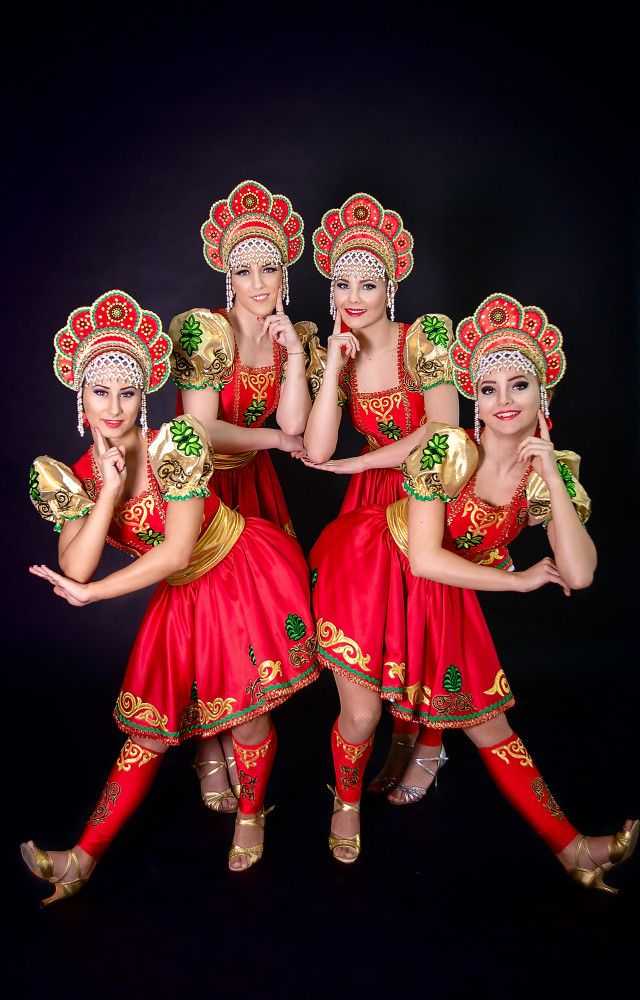 Children, old people, men and women can take part in the round dance. That is why this Russian dance has come down to our days, which serves as a symbol of bright solar energy, transmitted through a chain from hand to hand.
Children, old people, men and women can take part in the round dance. That is why this Russian dance has come down to our days, which serves as a symbol of bright solar energy, transmitted through a chain from hand to hand.
However, the Russian dance had more than just ritual significance.
Secret martial art of Russian women.
Few people know that the ancient Slavs were not at all defenseless when they were alone in the village, without men, with old people and children in their arms. Among them were women - Beregini, who mastered the dance, or rather a real martial art, which, under the guise of seduction, hid a powerful effect on a person's biologically active points.
If the enemy entered the village, open resistance could lead to the death of the whole family. It was also impossible to use herbs and poisons, since the same food and water were forced to be given to children. And the women went to the trick. For centuries, a dance has been honed, akin to oriental martial arts of internal influence, based on a deep knowledge of not only physiology, but also the biologically active contour of a person. One can only marvel at the depth of knowledge of our ancestors.
For centuries, a dance has been honed, akin to oriental martial arts of internal influence, based on a deep knowledge of not only physiology, but also the biologically active contour of a person. One can only marvel at the depth of knowledge of our ancestors.
Russian dance Beregini.
The bewitching dance was a complex, well-thought-out system in which all movements were subject to clear time intervals, and the plasticity of movements hid blows that seemed to be delivered into the void, but aimed precisely at the limbs of a stranger. He himself, fascinated by the flexibility of the dancer, her deliberately invocative movements, looked at her with voluptuousness and did not suspect how strong the weapon was directed against him. And the woman during the dance, arching her whole body, clinging to the ground and then sharply "floating" on the man, methodically inflicting invisible blows, changed the resonant-wave characteristics of her own biofield and processed his biologically active zones.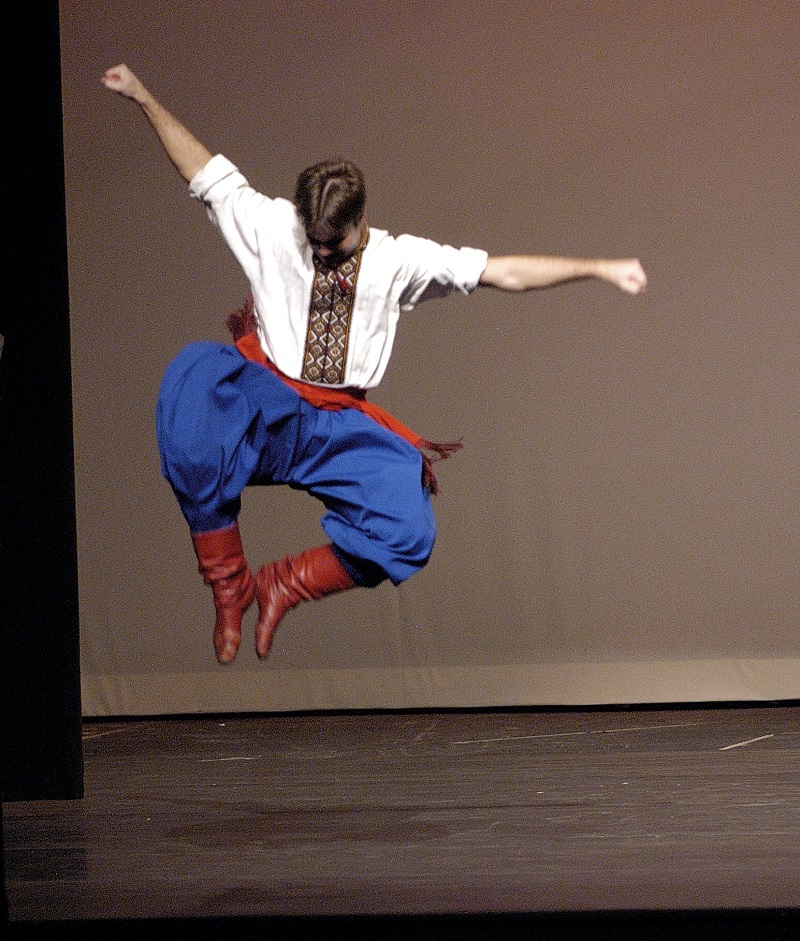 The dance simply caused a malfunction in the systems of the enemy organism and was a formidable slow-acting weapon.
The dance simply caused a malfunction in the systems of the enemy organism and was a formidable slow-acting weapon.
A similar Russian dance is also mentioned in connection with the fact that the ancient beauties treated their men in this way, with the difference that they affected other points. Causing a strong sexual arousal in a loved one through dance, they greatly increased his sensory perception, activated resonant-wave structures and "started" the balancing of the body. Wounds received in battles healed faster, and signs of various diseases disappeared.
Maybe it's not for nothing that some doctors recommend sex as a cure for headaches?
But let's not get carried away, but rather give our answer to the West.
We dance not for the sake of warmth, but for fun!
Such complex and energetic elements of Russian dance as “Pistol”, “Pike”, “Barrel”, “Goat”, “Arabic”, “Bedouin”, “Raznozhka” and others can only partly be considered as a means of warming the body. The dynamics of Russian dance was formed under the influence of two more reasons.
The dynamics of Russian dance was formed under the influence of two more reasons.
Firstly, pagan culture left a noticeable imprint on Russian folk dance. People in those days felt themselves an integral part of the world around them. Therefore, Russian dance was often based on imitation of the behavior of animals and birds, or reflected natural phenomena. “Crane”, “Gusachek”, “Dergach”, “Bullhead”, “Metelitsa” - there are no such names in Russian dance. Russian folk dance could imitate the haughty gait of a black grouse, cockfights, jumping roe deer, bear impudence, and therefore its pattern often had rather sharp movements.
Subsequently, such imitation became the basis of one of the genres of Russian folk dance - play. “Fish”, for example, a guy came out to dance - he began to jump, spin and stomp his feet, then suddenly fell to the ground and exactly repeated the movements of the fish thrown onto land. He bent so that the heels at the back of his head turned out to be. The play Russian dance especially amused the people, since it included not only the imitation of the habits of animals, but also the desire of the dancer to give the character traits of a human character.
The play Russian dance especially amused the people, since it included not only the imitation of the habits of animals, but also the desire of the dancer to give the character traits of a human character.
Secondly, the Russian dance was assimilated with the militant dances of unfriendly neighbors. During numerous wars, occupations and long captivity, a mixture of cultures took place. Cheerful and carefree Slavic dances, smooth and unhurried dances were saturated with new energetic elements. This is also evidenced by the names of the elements themselves, for example, the same "Arabic" and "Bedouin".
But no matter how great the influence of other cultures on Russian dance was, the people passed all the changes through the prism of their spirituality and presented us, as a result, an original and vibrant art.
Let's see what dance heritage our ancestors left behind.
Russian dance "Squatting".
This colorful Russian dance was presented to us in 1113 by the Grand Duke of All Rus' Vladimir Monomakh, who spotted in Kyiv a daring young man - a bricklayer Petro Prisyadka. After a hard day at work, Petro used to take it “on his chest” and went out to Khreshchatyk to stretch his stiff leg muscles, jumping vigorously. There he was noticed by Monomakh with his strange dance and soon danced for the prince at every breakfast, lunch and dinner. The Russian dance "under the squat" quickly became fashionable and was carried by buffoons throughout Rus'.
After a hard day at work, Petro used to take it “on his chest” and went out to Khreshchatyk to stretch his stiff leg muscles, jumping vigorously. There he was noticed by Monomakh with his strange dance and soon danced for the prince at every breakfast, lunch and dinner. The Russian dance "under the squat" quickly became fashionable and was carried by buffoons throughout Rus'.
Folk game dance and dance - the language of communication.
Interestingly, Russian dance, for the most part, has simple and capacious names that clearly reflect either the pattern of the dance, or the number of dancers, or the music to which it is performed, or a certain plot. Among the dances - improvisations are widely known: "Lady", "Balalaika", "Dance with Spoons", "Veselukha", "Topotukha", "Monogram", "Boots", "Timonya", "Polyanka", "Siberian Fun" ”, Russian dance “Matryoshka”, “Pleskach”, “Circular-dancing”, “Kamarinskaya”, “Polka”, “Chebotukha”, “Canopy”, “Gate”, “Steam Room”, “Four” and others.
All Slavic dances have a characteristic feature - cheerfulness and a pronounced sense of self-worth. What unites Russian folk dances is a demonstration of prowess, a breadth of movements that echoes lyricism and modesty, as well as fullness of meaning.
Russian dance is not danced, but as if they are telling something... They are telling beautifully, emotionally. With a glance, expressive facial expressions, gestures, the dancer conveys a story, no worse than a real theater actor. Same "Kamarinskaya" eloquently reproduces the arrogant, boastful exit of a drunken Kamarinsky peasant, jokingly plays up the "disobedience" of the rampant legs, sincere surprise and a cheerful brawl.
Russian dance requires majestic, swan-like smooth movements from women and energy from men. But he is also often mischievous and mischievous. For example, the Russian folk dance "Trepak" is lively, dynamic, where the partner and the partner perform fractional steps and stamping, jumping and whirling at a fast pace, they can freely improvise and turn on others from the first minute of performance. And the costumes for him are chosen completely different: short colorful sundresses, skirts flying out of the sun and bright embroidered blouses. Trepak can be performed as a single male dance or a pair dance.
And the costumes for him are chosen completely different: short colorful sundresses, skirts flying out of the sun and bright embroidered blouses. Trepak can be performed as a single male dance or a pair dance.
Another great Russian dance is "Troika" where a man dances with two partners. Folk art could not ignore the invariable symbol of any holiday - the Russian troika. The dance imitates it, representing galloping horses harnessed to a wagon. And again, imitation of animals is the observance of old traditions.
At holidays, fairs, weddings, Russian dance often acquired a competitive character - dance . And now the dance is very popular in folk dance. Two dancers participate in a kind of dance duel. Many elements can be used in the dance, and their combination and sequence is pure improvisation of the dancer. The participants of the dance compete in strength, agility, endurance and ingenuity. The task is to dance the opponent.
Such a variety of dances makes it possible to express any feelings and emotions, "adapt" Russian dance to any important event, make it a means of releasing excess energy and getting aesthetic pleasure.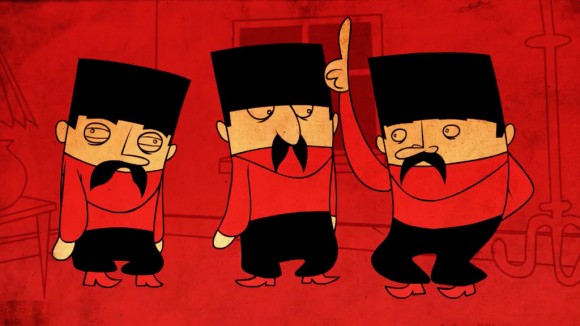 In the modern interpretation, Russian dance is still rich and original, and deserves the closest attention.
In the modern interpretation, Russian dance is still rich and original, and deserves the closest attention.
Expressive Russian dance is capable of instilling good taste, the ability to move beautifully, gracefully hold one's body and, most importantly, is completely devoid of vulgarity.
Russian folk dances are characterized by bright costumes. Basically, these are red, white, blue, green colors that symbolize love, purity of soul, sun, sky, fresh spring grass.
And all this, combined with excellent choreography, gives a stunning picture of Russian folk dance, which has no equal in the world dance history.
Russian dance squats | horeograph.COM
Today I will start talking about the male movements of the Russian folk dance and the first will be the squats. Agree, this is an integral part of the male dance.
So, what is a sweetheart? A squat is a movement peculiar only to a male dance, the basis of which is a deep squat.
Squats are divided into two types:
1st type. Performer rises to height after each deep squat.
Performer rises to height after each deep squat.
2nd view. The performer does the entire movement in a deep squat, without rising to height.
Performing squats of the 1st type .
The performer, jumping a little, squats sharply and deeply on half-toes in 1st position, heels together, toes apart, knees directed to the sides. Then the performer rises from a deep squat, jumping slightly, and descends from a jump either on both legs or on one leg.
When descending into a deep squat, it is necessary to keep yourself on the elastic muscles of the thigh and lower leg until the end of the movement, without putting a load on the knee joint.
During the whole squat, the body is straight and taut. It is necessary to hold the back firmly, tensing the muscles and connecting the shoulder blades. Under no circumstances should you lean forward.
Squats of the 1st type can be performed separately and in combination with other movements - with a pick, crackers, jumps, etc.
Squats of the 2nd type.
Compared with squats of the 1st type, they are more diverse in execution technique. In some of them, the performer, without getting up from a deep squat, alternately jumps from one leg to another, in others, leaning on one leg and raising his free leg, rotates on the supporting leg, etc.
Squats of both 1st and and the 2nd type can be performed on the spot and moving forward or to the side, with the exception of the “top”, which is always performed on the spot.
Consider squats that belong to type 1
Squat with leg forward
The performer rises from a deep squat alternately on one leg, then on the other, simultaneously throwing his free leg forward. Starting position of the legs: 1st position. Musical size: 2/4.
Raz The performer, from a slightly noticeable jump, sharply and deeply squats on the floor -
toes of both feet in 1st position, heels together, toes apart, knees directed to the sides.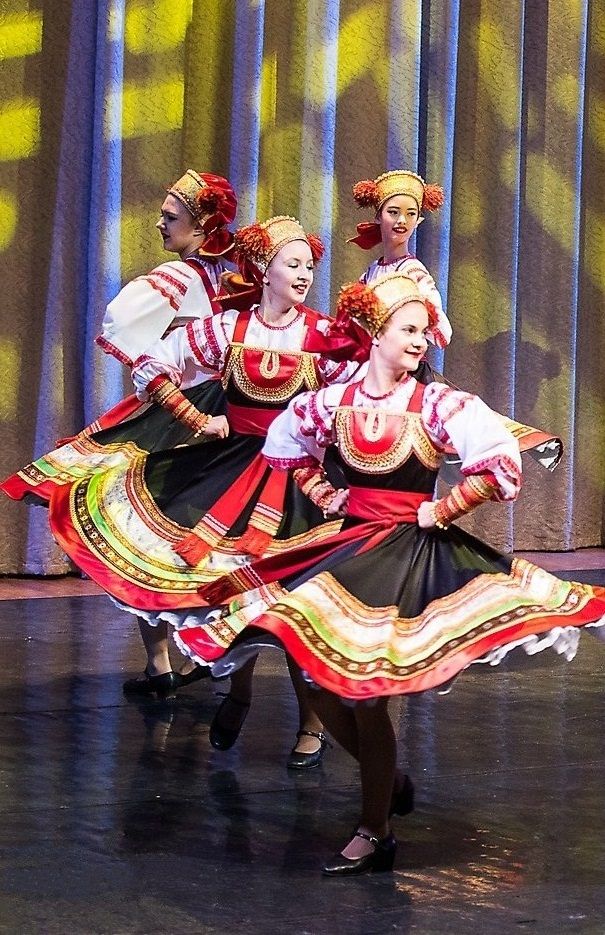
AND Pause.
Two The performer with a slight jump rises from a deep squat
and descends onto the low half-toes of the left leg bent at the knee. The right leg rises low forward, free at the knee and instep.
AND Pause.
Movement continues on the other leg. The body is straight.
In this squat, you can throw your leg not straight forward, but forward across the supporting leg. When the right leg is lifted forward across the left leg, both hands are thrown to the right, not above the waist, the elbows are free, the head is raised slightly turned to the left shoulder; when the left leg is raised, the arms are moved to the left, the head turns to the right shoulder.
Lateral squat with leg out to the side
The performer rises from a deep squat on one leg while simultaneously lifting his free leg to the side. Starting position of the legs: 1st position. Musical size: 2/4.
(One) The performer from a slightly noticeable jump abruptly and deeply squats on the semi-
toes of both feet in the 1st position, knees directed to the sides. The body is straight, the head is directed towards the viewer.
(I) Pause.
(Two) The performer rises sharply from a deep squat, slightly bouncing to the right, and descends either on the entire foot or on the low half-toes of the right leg bent at the knee. The left leg rises low to the left and slightly forward, the knee and instep are free. The body is either straight or slightly inclined towards the supporting leg, the head is raised and turned towards the left shoulder. The right arm is raised to the right, the left one lies on the side of the waist,
(I) Pause.
The movement is performed either alternately with one and the other foot or all the time with one foot: the performer bounces several times to the right on the right foot and raises the left foot to the left (and vice versa).
This squat can be performed in a slightly different way: without raising the free leg to the side, but placing it to the side on the heel. The supporting leg after the jump falls on the entire foot, the knee is more bent. The movement can be performed at a fast and medium pace.
Heel slip squat to 2nd position
Performer rises from deep squat on both feet and slips into 2nd position on heels. Starting position of the legs: 1st position. Musical size: 2/4.
(One) The performer, from a slightly noticeable jump, sharply and deeply squats on the half-toes of both legs in 1st position, knees directed to the sides,
(I) Pause.
(Two) The performer, rising sharply from a deep squat, slips on his heels to the sides, into a wide reversible 2nd position. The knees are extended.
(I) Pause.
On the count of "one" of the next measure, the performer descends from heels from a slightly noticeable jump into a deep squat in 1st position.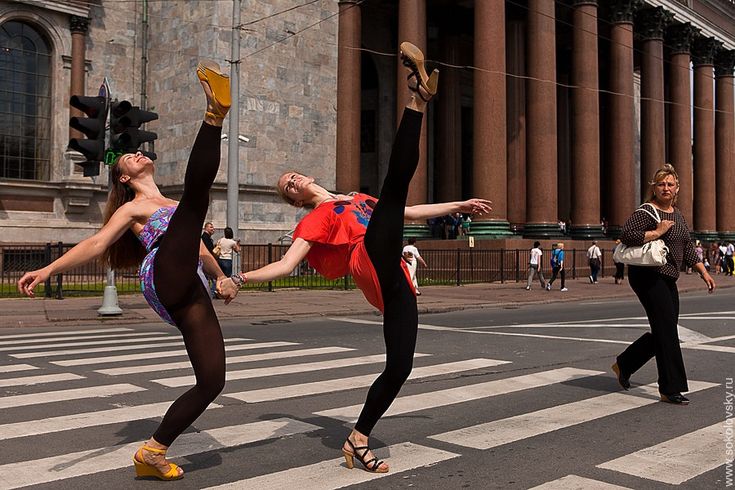 The body is straight.
The body is straight.
Squatting with jumping on toes and jumping on heels
The performer rises from a deep squat on the toes of both legs, then jumps to heels in 2nd position. Starting position of the legs: 1st position. Musical size: 2/4.
(One) The performer, from a slightly noticeable jump, sharply and deeply squats on the half-toes of both legs in 1st position, knees directed to the sides.
(R) The performer with a slight jump rises sharply from a deep squat and jumps on the half-fingers in the reverse 2nd position. The knees are bent and directed inward, that is, one to the other, the feet are directed to the sides.
(Two) From the half-toes the performer jumps to the heels of both legs, placing them in the 2nd position and extending the knees.
(I) Pause. Straight body.
Squat with slipping on heels with one foot forward, the other back
Performing this type of squat, the performer turns after two deep squats half a circle, either with his back or facing the viewer.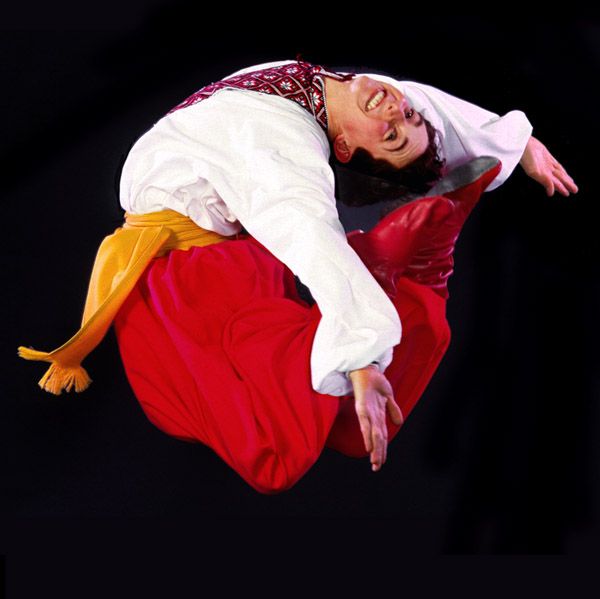 Starting position of the legs 1st position. Musical size: 2/4.
Starting position of the legs 1st position. Musical size: 2/4.
The movement takes four measures.
1st measure
(One) The performer from a slightly noticeable jump. Squats sharply and deeply on the half-toes of both legs in 1st position, knees directed to the sides.
(I) Pause.
(Two) The performer, rising sharply, slips on the heels of both legs, while the right leg is pushed forward, the left is retracted. The knees are extended.
(I) Pause.
2nd measure
(One) The performer descends sharply from heels from a slightly noticeable jump into a deep squat on half toes in 1st position.
(I) Pause.
(Two) The performer, rising sharply, with a slight jump, turns half a circle to the left, with his back to the viewer and slips on the heels of both legs, pushing his left leg to the back of the stage and moving his right leg back, towards the viewer.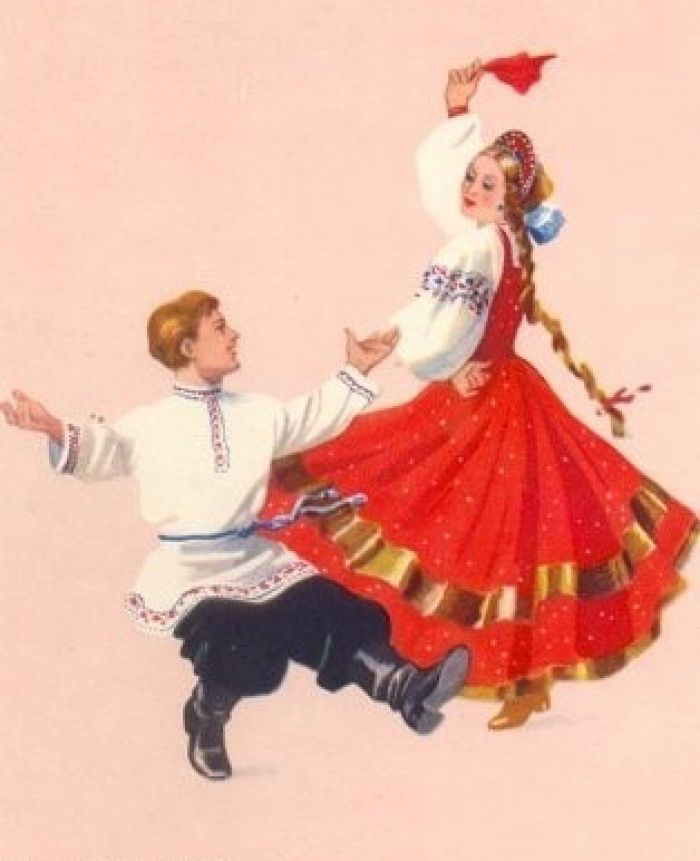 The knees are extended.
The knees are extended.
(I) Pause.
3rd measure
(One) Deep squat, as in the 1st measure, but with the back to the viewer.
(I) Pause.
(Two) The performer, rising sharply with his back to the viewer, slips on the heels of both legs, pushing his right foot to the back of the stage, moving his left foot back towards the viewer.
(I) Pause.
4th measure
(One) Deep squat, as in the 1st measure, but with the back to the viewer.
(I) Pause.
(Two) The performer, rising sharply, with a slight jump turns half a circle to the left, facing the viewer and slips on the heels of both legs,
pushing the left leg forward, right back,
(I) Pause.
The body is straight during the entire movement. Hands in position No.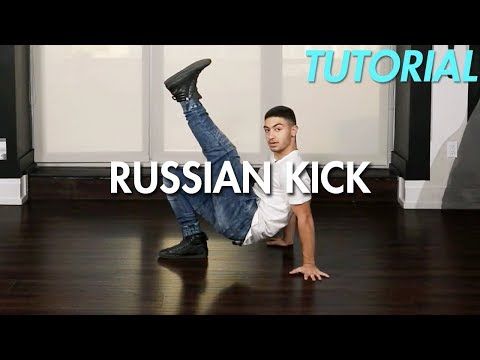 1. The movement is performed clearly, easily, lively. The pace is slow, medium or fast.
1. The movement is performed clearly, easily, lively. The pace is slow, medium or fast.
Pryadka “with a pick”
The performer rises from a deep squat on one leg, then makes a “pick” movement with the other leg. Starting position of the legs: 1st position. Musical size: 2/4.
(One) The performer sharply and deeply squats on the half-toes of both legs in 1st position, knees directed to the sides. The body is straight, the head is straight.
(S) The performer with a small jump rises sharply from a deep
squat on the entire foot of the right leg, bent at the knee. The left leg, bent at the knee, is placed permanently on the toe, at a distance of a foot to the left of the toe of the right leg, the knee is directed to the right, the foot is to the left. The body is slightly turned with the left shoulder forward, the head is towards the left shoulder,
(Two) The left leg, stretching at the knee, is placed on the heel forward and slightly to the left.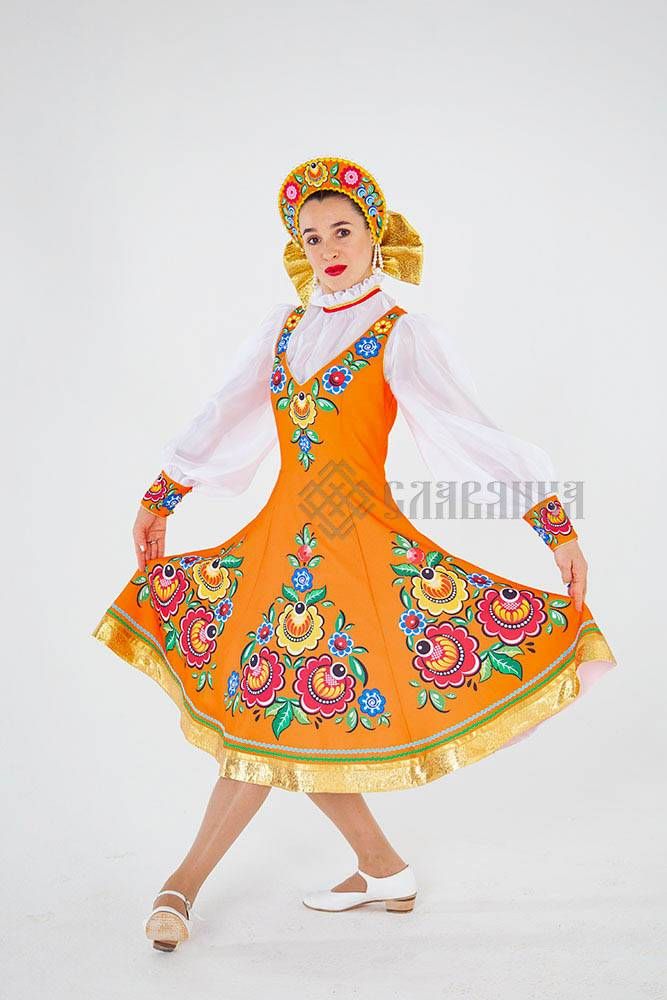
The body and head turn towards the left leg.
(I) Pause.
The movement continues with the other leg and can be done with a triple pick after one deep squat.
Squatting with palm strikes on the top of the boot
The performer, having risen after a deep squat on one leg, raises the other leg forward and strikes the top of the raised leg with his palm. Starting position of the legs: 1st position. Musical size: 2/4.
(Raz ) The performer, jumping a little, squats sharply and deeply on the half-toes of both legs in 1st position, knees directed to the sides. Body straight, head straight,
(I) Pause.
(Two) The performer with a slight jump rises abruptly to the entire foot of the right leg, at the same time lifting forward the left leg slightly bent at the knee and hitting the top of the boot of the left leg with the palm of the right hand. After the blow, the right hand approaches the front of the body. The left hand is turned to the left. The body is tilted to the right side, the head is turned and tilted towards the hand making the blow.
The left hand is turned to the left. The body is tilted to the right side, the head is turned and tilted towards the hand making the blow.
(I) Pause
With the next measure, the movement is repeated and the performer strikes the top of the right leg with the palm of his left hand.
The second version of this movement: on the count of “two”, the performer strikes with his palm not on the top, but on the sole of the boot.
Third option: instead of hitting the boot shaft on the count of "two", the performer can make a simple hand clap under the knee of the leg raised up. In this case, the leg rises forward without eversion with a slightly bent knee pointing forward.
Squats of the 2nd type
Slider. "Slider" of the 1st type.
Without rising from a deep squat, the performer jumps on half-toes from one foot to the other, alternately throwing forward either the right or the left leg.
Starting position: the performer is in a deep squat in 6th position, on half-fingers, knees directed forward.
Time signature: 2/4.
(One) Having slightly jumped, but not rising from a deep squat, the performer jumps to the half-toes of his left foot. The right leg rises forward, stretching at the knee, the rise is free.
(S) Pause.
(Two) Without rising from a deep squat, the performer jumps to the half-toes of the right foot. The left leg is lifted forward, the lift is free, and (I) Pause.
When performing a “slider”, you cannot “settle”, giving a load on the knee joint: during the entire movement, you must keep the weight of the body on the elastic muscles of the thigh and lower leg. The body is straight, taut. Hands are in position No. 1, No. 2, in 2nd position, etc. The "slider" is performed easily, lively, at a fast, medium and slow pace.
"Slider" type 1 can be combined with hand claps under the leg extended forward. Claps are made either simultaneously with throwing the leg forward, that is, at the expense of “one” and “two”, or after throwing the leg out, that is, at the expense of “one-and”, “two-and”. During clapping, the body is tilted forward.
During clapping, the body is tilted forward.
Slider, type 2.
Jumping from foot to foot is performed as in the 1st form. The only difference is that, throwing the leg forward, the performer puts it on the heel.
Jumping from foot to foot is performed in the 1st position, the legs are alternately thrown not forward, but to the side.
Spinning top
The performer rotates on one leg, in a deep squat, helping the rotation with his hands, which rest on the floor with his palms. The performer is in a deep squat on the half-toes of the right leg, the knee and toe are directed forward. The left leg is raised to the left or forward and is in the air all the time during the movement.
The body is strongly inclined forward towards the supporting leg. Hands rest with palms on the floor at a shoulder-width distance, fingers pointing forward. In this position, the young man performs a rotation to the right, quickly moving his hands along the direction of rotation, i.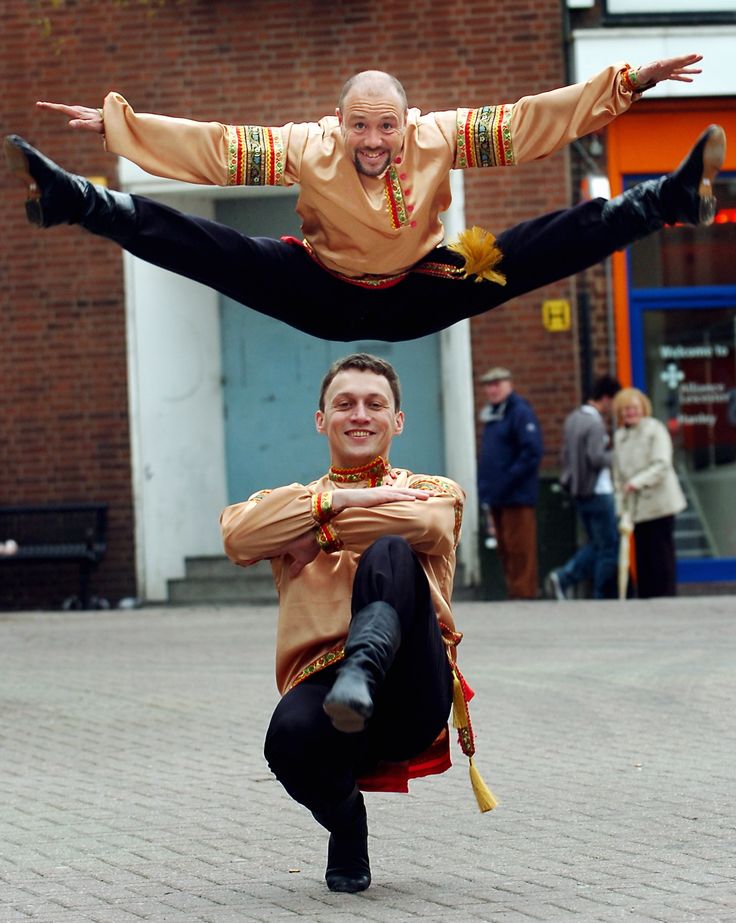 e., alternately lowering the palm of his right hand, then his left hand, to the floor, for every eighth measure. The supporting leg rotates in place, on the ball of the foot.
e., alternately lowering the palm of his right hand, then his left hand, to the floor, for every eighth measure. The supporting leg rotates in place, on the ball of the foot.
“Ball”
From a deep squat, the performer jumps slightly up with legs tucked in and crossed, then lowers himself onto the half-toes of both legs. Starting position of the legs: 1st position. Musical size: 2/4.
(One) The performer, having jumped up, sharply falls on half-fingers into a deep squat in 1st position.
(I) The performer, without rising from a deep squat, jumps up low, crossing his legs, bent at the knees, right in front, left behind.
(Two) The performer descends from a jump into a deep squat on the half-toes of both legs in 1st position.
(R) Jump up, as if counting "one-and", crossing legs, left in front, right
in the back.
The performer in this type of squat should bounce low from the floor, elastically, like a ball after hitting the floor.

